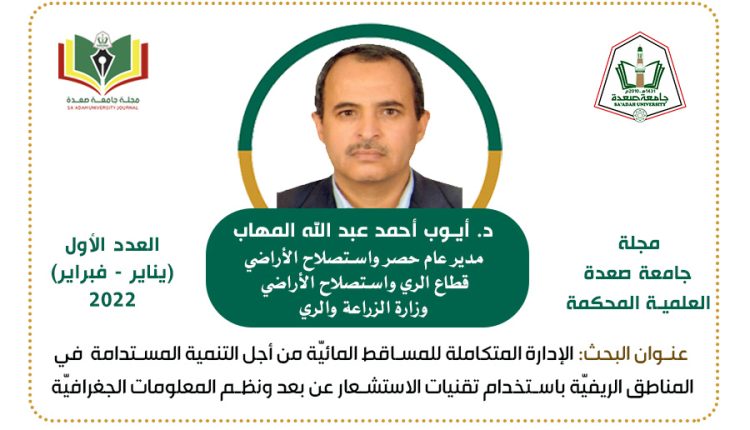الإدارة المتكاملة للمساقط المائية من أجل التنمية المستدامة في المناطق الريفية باستخدام تقنيات الاستشعار عن بعد ونظم المعلومات الجغرافية
الإدارة المتكاملة للمساقط المائية من أجل التنمية المستدامة في المناطق الريفية باستخدام تقنيات الاستشعار عن بعد ونظم المعلومات الجغرافية، دراسة حالة وادي مور – اليمن
د. أيوب أحمد عبدالله المهاب
الملخّص: وفّرت التكنولوجيّات والتقنيات الحديثة في العصر الحاضر الرّبط بين مزيج من قواعد البيانات المكانيّة وغير المكانيّة باستخدام تقنيات الاستشعار عن بعد (RS) ونظم المعلومات الجغرافيّة (GIS). ليس فقط للتخطيط على المستوى الكلّي للمسقط المائيّ، ولكن أيضًا تمّ تطوير نماذج حديثة من أجل التخطيط على المستوى الجزئيّ (المحليّ) للتنمية المستدامة، وخاصّة في المناطق الرّيفيّة. تم إجراء هذه الدراسة لمستجمع مياه وادي مور – غرب اليمن؛ بهدف توثيق التغيّر في استخدام الأراضيّ في نظام مستجمعات المياه، باستخدام تقنيات الاستشعار عن بعد ونظم المعلومات الجغرافيّة. في هذه الدراسة تمّ تجميع وتحليل صور القمر الصّناعيّ الأمريكيّ لاندسات (ETM+ & TM)، خلال الأعوام: 1990م، و2000م، و2011م. كما تمّ إنشاء قاعدة بيانات مكانيّة عن استخدام الأراضيّ، وخطوط الكنتور، وتفرّعات تصريف المياه (الوديان الفرعيّة).. وغيرها، بالاعتماد على خرائط الارتفاعات الرقميّة (DEM)، والبيانات الأساسيّة، مثل بيانات الخرائط الطبوغرافيّة – هيئة المساحة، صنعاء، اليمن، وتمّ الاستفادة من نظام التحليل المكانيّ (GIS). كما تمّ استخدام البيانات والخرائط الأساسيّة هذه لاستنتاج الطبقات التخصّصيّة لهياكل البيانات المطلوبة، مثل الميل أو الانحدار، واتجاه سريان المياه، والتعرية، والغطاء الأرضيّ، واستخدام الأراضيّ.
أظهرت النتائج تحوّلات مختلفة في استخدام الأراضيّ داخل مستجمع وادي مور في الفترة قيد الدراسة من 1990م إلى 2011م. فقد انخفضت الأراضيّ العشبيّة من 21.5٪ في 1990م إلى 14.6٪ في الفترة من 1990م إلى 2011م، بينما انخفضت الأراضيّ الحراجيّة من 8.9٪ في 1990م إلى 6.23٪ في 2011م. وارتفعت الأراضيّ الزراعيّة من 31.3٪ في عام 1990م إلى 34.2٪ في عام 2011م.
وقدّمت نتائج هذه الدراسة حلولاً مناسبة للمشاكل الخاصّة بالمناطق المدروسة، ويمكن تعميمها على مستجمعات المياه الأخرى في البلاد.
الكلمات المفتاحيّة: الإدارة المتكاملة للمساقط المائيّة، مستجمعات المياه، الخرائط الطبوغرافيّة، التنمية المستدامة، الاستشعار عن بعد، نظم المعلومات الجغرافيّة.
اضغط الرابط للإطلاع على الدراسة: https://drive.google.com/file/d/1bDk1f66NalP0Tekey59bhySrZ_ztiZml/view?usp=share_link

